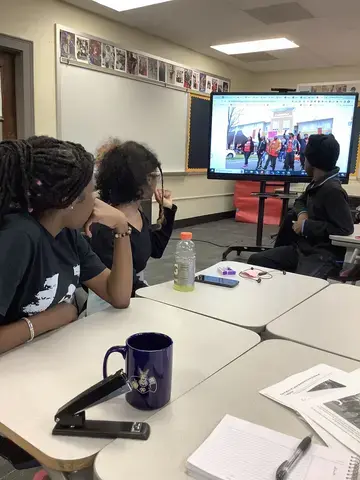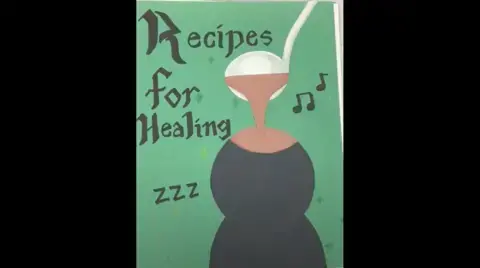This unit was created by Karen Sojourner, a high school English Language Arts teacher in Kansas City, MO, as part of the 2022-2023 Pulitzer Center Teacher Fellowship program. It is designed for facilitation across six 90-minute class periods, with work outside of class.
For more units created by Pulitzer Center Teacher Fellows in this cohort, click here.
Objectives:
Students will be able to…
- Recognize and define the three parts of trauma: Event, Experience, and Effect.
- Analyze various video and text resources to evaluate the impact of violence and victimization on communities.
- Analyze the role of storytelling in supporting advocacy and healing.
- Interview local advocates to research strategies for healing and action in the face of harm in a community.
- Synthesize their learning into a guide for students their age that articulates tips for advocacy and healing in the face of harm.
Unit Overview:
Students engage with journalism, short films, local interviews, and self reflection to expand their definitions of advocacy, explore the causes and impacts of trauma, and ultimately compose a recipe book for healing.
Students start the unit by talking about advocacy and what advocacy looks like in a broad sense. Students then more closely examine what advocacy looks and feels like on a personal level through explorations of news stories and short films. They also reflect on what self-advocacy can look like while in the midst of traumatic circumstances.
Students interact with resources such as film shorts, documentaries and articles related to self advocacy and resilience. They then apply their analyses of these resources to the creation of a recipe book with tips for healing in their communities.
Essential Questions:
- How are communities navigating traumatic experiences and invoking community action/advocacy?
- What are the different emotions that emerge from loss, and what are healthy ways to engage with those emotions?
- How are individuals navigating these experiences and invoking action/advocacy for themselves?
- What is the role of storytelling in supporting healing and inspiring informed action?
- Who is responsible for telling the story? Why does that make a difference?
Performance Task:
Students will create "trauma-informed recipe books" that will offer their own suggestions for guidelines to mitigating trauma. The suggestions will be informed by their analyses throughout the unit.
Assessment/Evaluation
Daily lessons will be evaluated on participation and completion. The final project will be evaluated using the Design Rubric/Scoring Guide for Final Project [.pdf] [.docx]
Six-lesson unit plan for teachers, including pacing, texts and multimedia resources, guiding questions for group discussions, performance task instructions, and grading rubric for the unit.
Unit Resources:
| Texts | “The Future of Labor Advocacy Is as Diverse as Workforce” by Herbert White for The Charlotte Post The Freedom Writers Diary by The Freedom Writers and Erin Gruwell |
| Videos | Video: “What are underreported stories?” from the Pulitzer Center Short films exploring loss: “A homeless 7-year-old who lives on the beach makes and sells 'stick people' to get by. | Jada” Directed by Doug Roland, 2017. (15:59) Oscars: A clumsy crochet dinosaur must unravel itself to save the love of its life. | Lost and Found. Directed by Andrew Goldsmith and Bradley Slabe, Screen Australia, 2018. (7:31) Oscars: A homeless teen meets a deaf-blind man who changes his life forever... | Feeling Through Directed by Doug Roland, Doug Roland Films, 2021. (18:26) *** If time and interest allows A DeafBlind man makes history starring in a film | 'Connecting the Dots' (doc to "Feeling Through") Directed by Doug Roland, Doug Roland Productions and Helen Keller National Center, 2021. (24:07) TRAUMA - Short Film Directed by Mark Kinsella, Fifty Nine Pictures, 2016. (6:43) Remembering Trauma Official Film (2017) Center for Child Trauma Assessment, Services, and Interventions (CCTASI) in collaboration with partners from the National Child Traumatic Stress Network (NCTSN) and creator of the ReMoved film series, Nathanael Matanick, 2017. (16:00) Trauma is irreversible. How it shapes us is our choice. | Sasha Joseph Neulinger | TEDxBozeman (9:17) are you okay? | Award-Winning Short Film, Directed by Ryan Cannon, Barbara Sinatra Children's Center Foundation, 2021. (8:46) Watch The Rebellious Life of Mrs. Rosa Parks Streaming Online | Peacock “KC Mothers Charge Fight Against Gun Violence” from KCTV5 News |
| Teaching materials | Advocacy Handout [.pdf][.docx] Types of Trauma handout with resources from the National Center on Safe Supportive Learning Environments [.pdf] [.docx] Exploring Evidence of Trauma in Short Films graphic organizer [.pdf] [.docx] Going to the Movies graphic organizer The Freedom Writers Diary graphic organizer [.pdf][.docx] Graphic organizer for analyzing news articles [.pdf][.docx] KC Mothers In Charge website Information and videos about What KC Mothers in Charge does for the families in the Kansas City area Lesson: Interview Techniques for Telling Underreported Stories from the Pulitzer Center Guide for final project [.pdf] [.docx] |
Social Justice Standards from Learning for Justice:
Standard 14: Students will recognize that power and privilege influence relationships on interpersonal, intergroup and institutional levels and consider how they have been affected by those dynamics.
Standard 15: Students will identify figures, groups, events and a variety of strategies and philosophies relevant to the history of social justice around the world.
The following examples capture engagement by students from Kansas City, Missouri who participated in this unit in spring 2023.
1. Students start the unit by evaluating their definitions of advocacy, the goals of advocacy, and the ways that storytelling can inform advocacy.
2. Next, students explore narratives about ways that communities are navigating loss and conflict. They evaluate definitions of trauma, explore ways that loss and conflict can lead to trauma, and use graphic organizers to analyze evidence of trauma in the narratives they explored.
3. Students then apply their analysis of different types of trauma, and the ways that stories can inform advocacy, to analysis of a Pulitzer Center-supported story. They also analyze the term, "underreported story," and consider the ways that advocacy can be informed by grief and stories from communities that have experienced trauma.

4. Students continue exploring connections between grief, trauma, storytelling, and advocacy by connecting with the local advocacy organization KC Mothers in Charge. KC Mothers in Charge advocates families who have lost a loved one to homicide, providing victim and family services, education and advocacy. Students prepare for their meeting by engaging with resources on interview skills for journalists.
5. Students close out the unit by developing recipe books for healing that reflect their analyses throughout the unit. Their books include reflections on ways to navigate depression, anxiety, isolation, and trauma.








